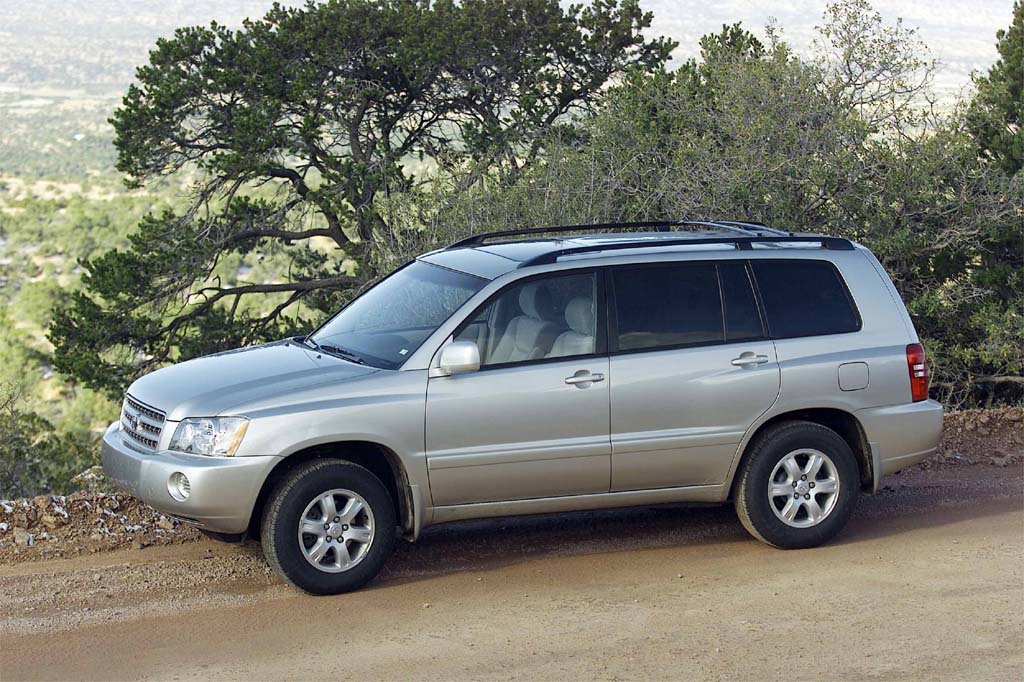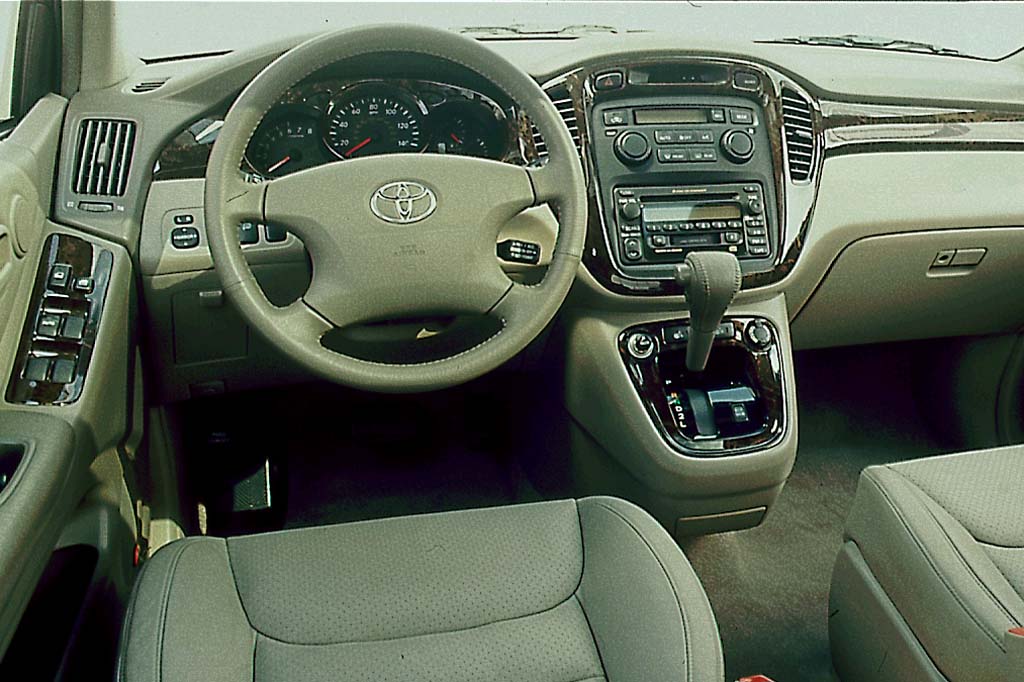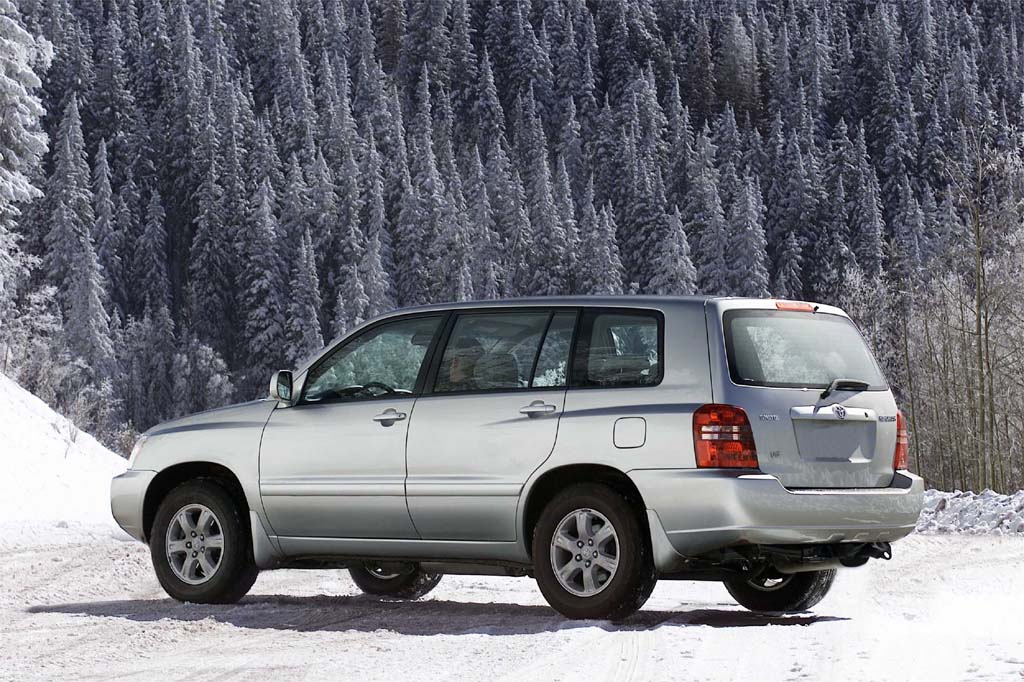| Midsize SUV; Built in Japan |
|
|
| Good condition price range: $5,300 – $17,700* |

2002 Toyota Highlander

2001 Toyota Highlander

2001 Toyota Highlander interior

2003 Toyota Highlander

2002 Toyota Highlander
| Pros: |
|
| Cons: |
|
Aside from slightly elevated ground clearance, Highlander doesn’t really do anything better than an AWD minivan would, sacrificing in the bargain such agreeable features as space-efficient sliding side doors and seven-passenger seating. That said, for most shoppers the Highlander is a far smarter choice than a truck-based SUV. Its all-around competence, pricing, and Toyota design make it more than a match for midsize SUVs of any stripe. New or used, it’s an easy Best Buy.
Overview
Adding a fourth sport-utility vehicle to the Toyota line, the new midsize 2001 Highlander was an under-the-skin sibling to the popular car-based Lexus RX 300. Both were built on the Toyota Camry/Lexus ES 300 sedan platform. Highlanders, however, displayed more traditional wagon styling than the RX and strode a 4 inch longer wheelbase, with most of the increase going to extra cargo room.
Toyota saw the Highlander as a midsize SUV for buyers interested more in on the-road comfort, refinement, and performance than in offroad ability and a truck-tough image. The unibodied Highlander was slightly longer than Toyota’s body-on-frame 4Runner, but stood about half an inch lower and 5 inches wider.
Two models were available: a price-leader four cylinder, and an upscale V6. The vast majority of sales were expected to be the better-equipped V6 version, which held Toyota’s familiar 3.0-liter engine. The sole transmission was a four speed automatic.
Like the RX, both Highlanders came with either front-wheel drive or all-wheel drive, which lacked low-range gearing. Toyota expected the V6 AWD to be the best-selling individual model.
Highlanders initially came in a single trim level, but with an upscale Limited package available. Standard equipment included air conditioning, a cassette/CD player, cruise control, and a tilt steering wheel. Limiteds added automatic climate control, an eight-way power driver’s seat, 16-inch alloy wheels, and a full-size spare tire. Antilock four-wheel disc brakes and 16-inch wheels were standard. An antiskid system and front side airbags were optional. Other options included a moonroof and (in V6 models) heated front seats and leather upholstery.
Seating five passengers, Highlanders went on sale during the first quarter of 2001. Competitors included the Acura MDX, Lexus RX 300, Mercedes-Benz M Class, Ford Explorer, and GMC Envoy.
Yearly Updates
| 2002 Highlander For 2002, Highlanders gained a standard rear-seat armrest, cabin air filtration, and a redesigned center console. Base and Limited models were offered. |
| 2003 Highlander A full-size spare tire was now standard, replacing the compact “space-saver” tire. Highlanders faced new competition from Honda’s Pilot. |
| 2004 Highlander Toyota added more power, an available 3-row seat, and optional curtain airbags to its midsize crossover SUV. A new 3.3-liter V6 with 230 horsepower replaced the old 3.0-liter unit. It mates to a 5-speed automatic. The optional 3rd-row seat ups passenger capacity to seven and folds flush into the floor. The optional curtain airbags protect only the front- and second-row passengers. |
| 2005 Highlander Midyear introduction of a gas/electric hybrid version highlights 2005 for this midsize SUV. The Hybrid combines the gas V6 and battery-powered electric motors for a total of 268 hp. It uses a continuously variable automatic transmission (CVT) and offers 2WD or AWD. Standard on Hybrids and optional on other models are head-protecting curtain side airbags covering the 1st and 2nd seating rows; front torso side airbags are included. |
| 2006 Highlander Midyear addition of a Sport model highlights 2006 for this car-type SUV. Sport models use the 3.3-liter V6 and get a sport suspension. |
| 2007 Highlander Side airbags and curtain side airbags are standard instead of optional for 2007 on all versions of this midsize car-type SUV. Previously standard only on Hybrids, all Highlanders now have front side airbags and curtain side airbags that cover the first two seating rows and include rollover deployment. |
